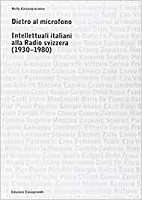| dc.contributor.author | Valsangiacomo, Nelly | |
| dc.date.accessioned | 2016-04-20 00:00:00 | |
| dc.date.accessioned | 2020-04-01T14:17:58Z | |
| dc.date.available | 2020-04-01T14:17:58Z | |
| dc.date.issued | 2015 | |
| dc.identifier | 606470 | |
| dc.identifier | OCN: 1030817329 | en_US |
| dc.identifier.uri | http://library.oapen.org/handle/20.500.12657/32742 | |
| dc.description.abstract | A gripping essay on the role that Italian intellectuals played in the organization and scheduling of Swiss public radio between the Fascist period and the so-called Anni di Piombo (Years of Lead). The book
What was the role of Italian intellectuals in the history of Swiss radio broadcasting culture? And what images of Switzerland and Italy were conveyed between 1930 and 1980?
Ever since it began in the 1930s, Italian-language Swiss radio, a national public service broadcaster addressed to a linguistic minority, drew from intellectual resources external to its own political borders, a characteristic that contributed to defining its profile. During the Fascist period, for example, Italian intellectuals could express themselves from the microphones of this radio with a freedom that they were not allowed in their home country: Benedetto Croce’s 1936 speech is a memorable case in point. Subse-quently, when the interview and debate formats tended to undermine that of the radio lecture, journalists and writers such as Pier Paolo Pasolini and Eugenio Montale took advantage of the debating space that Swiss Italy offered them.
By analysing the written and audio sources, many of which unpublished, Nelly Valsangiacomo’s essay reconstructs a complex as well as fascinating radio broadcasting panorama, brought to life by the voices of some of the greatest Italian intellectuals, such as Elio Vittorini, Maria Corti, Indro Montanelli, and Dario Fo. Voices that can now be listened to once again thanks to a web page completing the book: www.rsi.ch/dietroalmicrofono (Radiotelevisione svizzera di lingua italiana/Italian-language Swiss Radio and Television) | |
| dc.language | Italian | |
| dc.relation.ispartofseries | Itinerari | |
| dc.subject.classification | thema EDItEUR::1 Place qualifiers::1D Europe::1DF Central Europe::1DFH Switzerland | en_US |
| dc.subject.classification | thema EDItEUR::2 Language qualifiers::2A Indo-European languages::2AD Romance, Italic and Rhaeto-Romanic languages::2ADT Italian | en_US |
| dc.subject.classification | thema EDItEUR::3 Time period qualifiers::3M c 1500 onwards to present day::3MP 20th century, c 1900 to c 1999 | en_US |
| dc.subject.classification | thema EDItEUR::A The Arts::AT Performing arts::ATL Radio / podcasts | en_US |
| dc.subject.classification | thema EDItEUR::N History and Archaeology::NH History::NHT History: specific events and topics::NHTB Social and cultural history | en_US |
| dc.subject.classification | thema EDItEUR::J Society and Social Sciences::JH Sociology and anthropology::JHM Anthropology::JHMC Social and cultural anthropology | en_US |
| dc.subject.classification | thema EDItEUR::W Lifestyle, Hobbies and Leisure::WQ Local and family history, nostalgia::WQH Local history | en_US |
| dc.subject.other | radio svizzera | |
| dc.subject.other | schweizer radio | |
| dc.subject.other | radio suisse | |
| dc.subject.other | intellectuels italiens | |
| dc.subject.other | intellettuali italiani | |
| dc.subject.other | italian intellectuals | |
| dc.subject.other | swiss radio | |
| dc.subject.other | italienische intellektuelle | |
| dc.title | Dietro al microfono. Intellettuali italiani alla Radio svizzera (1930-1980) | |
| dc.type | book | |
| oapen.abstract.otherlanguage | Qual è stato il ruolo degli intellettuali italiani nella storia della cultura radiofonica svizzera? E quali immagini della Svizzera e dell’Italia sono state veicolate tra il 1930 e il 1980? Fin dai suoi esordi negli anni Trenta, la Radio svizzera di lingua italiana, emittente nazionale di servizio pubblico rivolta a una minoranza linguistica, attinse a risorse intellettuali esterne alle proprie frontiere politiche, caratteristica che contribuì a definirne il profilo. Durante il ventennio fascista, ad esempio, gli intellettuali italiani poterono esprimersi ai microfoni di questa radio con una libertà che in Patria non si sarebbero concessi: memorabile in tal senso il discorso di Benedetto Croce del 1936. In seguito, quando le forme dell’intervista e del dibatti-to tenderanno a scalzare quella della conferenza radiofonica, saranno giornalisti e scrittori come Pier Paolo Pasolini o Eugenio Montale ad approfittare di quello spazio di confronto che la Svizzera italiana offriva loro.
Attraverso l’analisi delle fonti scritte e sonore, molte delle quali inedite, il saggio di Nelly Va-lsangiacomo ricostruisce un panorama radiofonico complesso e affascinante, animato dalle voci di alcuni tra i più grandi intellettuali italiani, come Elio Vittorini, Maria Corti, Indro Montanelli e Dario Fo. Voci che ora possono essere riascoltate grazie a una pagina web creata a complemento del volume: www.rsi.ch/dietroalmicrofono. | |
| oapen.identifier.doi | 10.26530/OAPEN_606470 | |
| oapen.relation.isPublishedBy | da585f67-cd45-40e9-a913-4afcc36fcd41 | |
| oapen.relation.isFundedBy | b70636da-dc2d-4755-a37e-360db651c0bf | |
| oapen.relation.isbn | 9788877137104 | |
| oapen.collection | OAPEN-CH 1st Call | |
| oapen.collection | Swiss National Science Foundation (SNF) | |
| oapen.imprint | Edizioni Casagrande | |
| oapen.pages | 18 | |
| oapen.place.publication | Bellinzona | |
| oapen.grant.number | 163551 | |
| oapen.identifier.ocn | 1030817329 | |

